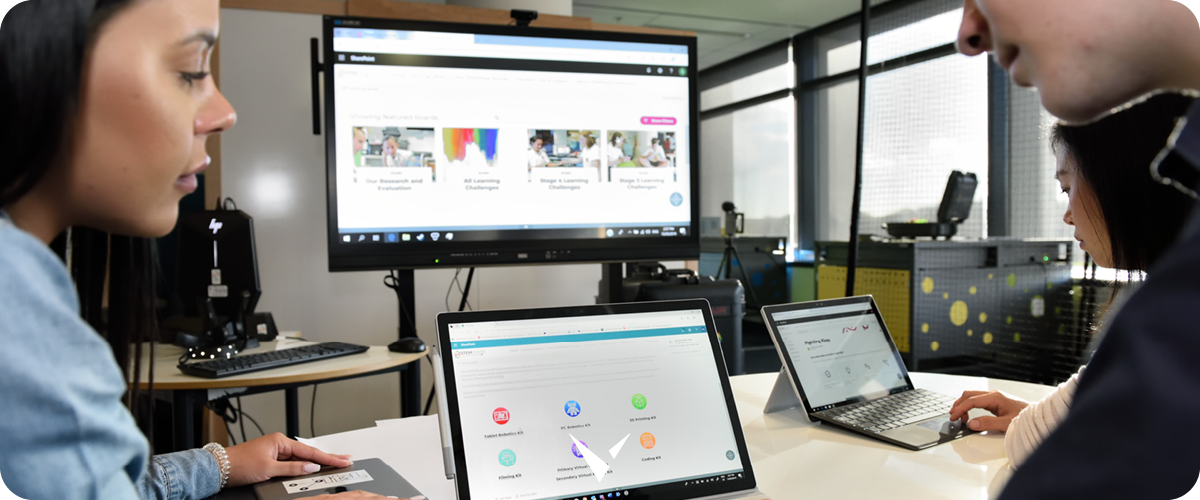Optimizing Your EdTech Stack: What You Need to Know
Like every industry in the world, the education industry is advancing and finding new ways to improve the learning process, such as incorporating EdTech stacks. However, developing countries are already facing a crisis with learning. Millions of children go to school but are not learning enough. Additionally, some statistics indicate that children are not learning to read until they reach ten years of age.
Children prefer an interactive way to learn better. Traditional teaching practices are slowly becoming obsolete, and time demands a modern and technological approach towards teaching children. This is where EdTech comes into play.
EdTech incorporates different solutions and technology to assist the learning process. According to a study by HolonIQ, conducted in August 2020, the global EdTech market is set to increase by 16.3% CAGR and reach $404 billion by 2025.
EdTech is gaining traction and can easily be seen as the future of education globally. Many schools have already started implementing EdTech Stack to help them streamline their teaching process. This article will talk all about the benefits of EdTech for students and teachers and the solutions a school can opt for in its pursuit of digitization.
Benefits of EdTech

Incorporating technology in any sector can drastically improve its efficiency. As a result, global industries are working towards automation to help simplify tasks. This can also be seen in the education sector; EdTech offers several benefits to students and teachers alike.
Students
Traditional education methods cannot be effective for our current generation. Yet, we are surrounded by technology from cognition and live within it throughout our lives. EdTech allows students to use technology to educate students in a comfortable environment. Recruiting technology to assist in learning can also promote inclusivity and collaboration. Here are the five ways EdTech is impacting the way students learn.
- Collaborative Environment
A student can learn better when collaborating with others; it also teaches them the value of teamwork. Several cloud-based applications and tools can promote collaboration in the classroom. From tablets that offer educational games to keep the student interested to cloud tools that allow the students to upload and discuss their homework is all a part of EdTech. This will enable students to solve problems together and learn each other's thought processes on how they solved them.
- 24/7 Access
Schools typically run from 8 in the morning to 2 in the afternoon. This gives students an 8-hour window to learn. Furthermore, the student must be physically present in the classroom. Failure to do can lead the individuals to miss out on lectures and hamper their learning.
The introduction of IoT devices in the classroom can help students attend classes from anywhere. Technology allows students to stay connected with their lectures and complete work at their own pace, whether at home or on the bus. This eliminates the restriction of needing to be physically present in the classroom. This flexibility allows students to function at a higher capacity, in turn retaining more information and performing well in tests
These devices and solutions assist the students in communicating with each other and with the teacher. A student can contact their teachers at any point for any further explanation and even inform teachers in an emergency.
- Simplified Class Sessions
The post-pandemic world has changed the way many things are done. The pandemic set the world into a lockdown situation. This continued long enough for schools to be forced to use digital means to carry on the students' progress. Edtech plays a major role in the transformation of traditional classrooms to online. Students can now use the help of video lectures and learning apps to study at their own pace while using class times to collaborate on projects and assignments. This type of system promotes creativity, self-learning, and collaboration amongst students.
Video lectures can let students take classes from the comfort of their own room. This can improve the efficiency of your lessons. Physically being present in the classroom can sometimes result in inefficiency due to the fatigue students experience from travel or spending an entire day in their classroom
Although physical classrooms mean that the teacher can make sure the student is getting their work done, online classrooms can help students learn more because of the comfortable environment.
- Customized Educational Experiences
No two students can ever be the same, and a generalized lesson plan cannot effectively teach. Instead, Edtech allows teachers to create personalized lesson plans for each student. This approach can help teachers customize their teaching practices based on the student's strengths, interests, and skills.
According to a study, an individual can retain 95% of the information in video form instead of 10% in text form. Furthermore, videos can allow students to learn at their own pace with the pause and rewind option available. All these steps can help students understand the lesson better and improve themselves.
EdTech also offers analytics on the coursework. This will allow teachers to see where each student struggled and provide extra help on the topic. This type of feedback cannot be achieved through traditional means, and the teacher has to rely on the students' grades before they can try and help.
Speaking of grades, tests and exams can cause more harm than good, considering the stress that comes along with it. Instead of relying on these tests, EdTech can help you measure academic success by using apps that can consistently track a student's overall aptitude. In addition, several EdTEch apps allow teachers to analyze learning trends and identify negative trends in the student. This will enable them to proactively address these issues before it becomes a problem.
- Captivating Lessons
Lessons can often get boring and overrun. Dozing off in a classroom is nothing out of the ordinary to keep the students' attention towards the course. Students are surrounded by gadgets and external influences that can hinder their attention. Furthermore, a student has an attention span of 10 to 15 minutes at best. Therefore, a lesson has to be gripping to keep the students hooked. Edtech experts say technology can be the solution to this. Some of the ways EdTech can help teachers improve a student's classroom participation can include interacting with other students and classrooms from around the world with the help of video conferencing. Students can also submit homework assignments as podcasts or videos and even gamifying problem-solving.
Related: The Role Of Technology In Personalized Learning
For Teachers
EdTech can make lessons and coursework interactive and simple. Still, students are not the only ones that can benefit from EdTech solutions. Teachers can use educational technology to develop strong learning practices and save them time in the classroom. Here are some ways that EdTech can help teachers improve the effectiveness of their tasks in a classroom.
- Automatic Grading Solution
Incorporating artificial intelligence and machine learning into the education sector can be a saving grace for teachers. There are several apps available that can help teachers automate their grading processes. These apps can assess and analyze answers based on the assignment's specifications.
These tools make the grading for objective assignments such as "true/false" or "Multiple Choice Questions" a breeze. Doing this can free up much time for the teachers to utilize by giving more one-on-one sessions to students struggling with lessons.
- Manage Classrooms
Classrooms can be chaotic to control for any teacher. However, educational technology can improve the communication between the student and teacher and how students behave in class. For example, several EdTech tools allow teachers to easily send reminders to students and their parents on upcoming homework assignments or projects.
Other tools enable the student to self-monitor the noise levels in the classroom. These management tools can help you maintain peace in the class and create a better, more collaborative environment.
- Eliminating Paper, Greener Policy
Teachers need to take stacks of paperwork and assignments to grade. Handling papers can be tedious and waste time and paper. But technology can eliminate the need for paper, allowing students to submit assignments online. These can then be graded, and results can be posted online. This not only safeguards hundreds of homework files and sorts them into a single space but also contributes towards greener policies.
Gone are when teachers have to carry a stack of classwork notebooks to and from school. Now all they need to bring is a laptop bag with maybe a charger, and they are good to go.
- Analyzing Student Progress
Every student is different and has a different skill set. Moreover, it can take a teacher countless hours to assess the skills of each of their students and work on them accordingly. Currently, the market has several tools that allow teachers to evaluate a student's skills and requirements and present the analytic data to the teachers.
Lesson plans can sometimes negatively affect certain students, leading them to struggle to understand the topic. It could take teachers months to identify the issue in their lesson plan when this occurs. However, several tools help teachers extract real-time data and use it to discover a student's skills, weaknesses, strengths, and even learning disabilities. This can help teachers take a proactive approach and plan to help their students.
- Digitized Classrooms
Writing on a blackboard or whiteboard can be hectic, and it causes a lot of back and forth. EdTech solutions offer screen mirroring software that allows teachers to use their devices and have their screen on the projector, allowing the students to see the work being done. This can make it easy for teachers to conduct classes without going back and forth from the board.
What is EdTech Stack?

An EdTech stack collects various apps and solutions that offer 360 functionality to your institute. These stacks can range from student management systems to full-fledged infrastructural changes that can completely digitize how you teach.
According to experts, an EdTech Stack is categorized into a hierarchy. This order has three levels: SIS, LMS, and LOR.
Student Information System
This is the first level of an EdTech stack that helps administrators store a student's data. For example, several details are required when a student enrolls in an institution. This can range from the student's identification to the grades from his/her last educational institute. Keeping all this data in physical documents can be difficult to sort through, not to mention the amount of space it will take up.
To have an efficient system for storing records, educational institutes worldwide integrate SIS into their workflows. Now, if a student has to change their information, or if a teacher requires a student's information, it can easily be located without going through thousands of documents.
Learning Management System
According to a study, 83% of global organizations use LMS for their training content. This can also be seen in the education sector. Learning management systems allow teachers to have a single platform to post assignments, get submissions from students, and give grades. The LMS software can also track a student's progress and eliminate paperwork.
After the pandemic hit, most educational institutes used learning management systems to assign and collect their students' assignments during the lockdown. The benefits of using this system were evident, and it is still used even after schools have reopened. LMS system offers a single platform and provides analytics about the students. Teachers can then use this data to improve their course outlines and cater to students that require extra help coping with a specific topic or subject.
Learning Objective Repository
There is no set way to teach. This is where the learning objective repository comes into play. The LOR is, in essence, a digital library where educators share their resources to help other teachers improve their lessons. These resources are often free to use by everyone unless specified otherwise. These are a great way to help each other and their students.
All three of these aspects come together to create an EdTech stack. However, there are several other aspects of EdTech that can be used in a classroom to improve efficiency and effectiveness for students.
Tools For EdTech Integration

With automation being the pinnacle of every organization, educators are looking to integrate automation into their systems. Furthermore, this technology needs to be adaptable to support other technologies. Certain IT managers in a school are required to fix a single supplier that will build the infrastructure of the entire school; for example, the computers in the school are all iMacs. The incorporated technology should be a 360 solution that is not dependent on a specific device, ensuring it is product agnostic.
Here are five of the most widely used tools:
LMS Tools
As we learned earlier, learning management systems are essential for every classroom. LMS can facilitate teachers in several ways. These include:
- Share resources and practices with teachers creating an object repository
- Promoting a collaborative environment, allowing students to work together on projects
- Manage homework and assignments
- Grading and sharing results on a single platform
- Access documents at any time from anywhere in the world
- Simplify communication between teachers, students, and parents
Gamifying Teaching Tools
Ordinary lessons and lectures can get boring fast. That is why teachers often use applications to incorporate games into their classes and keep learners engaged.
One great example of this is SluethIT. It is a detective EdTech game that helps children learn several subjects. These games often have a full course worth of resources per game. Gamifying lessons can be considered the future of education.
Assistance Tools
You can often run into complications when studying. Whether you are a student or a teacher, specific tools can help you complete assignments. Several assistance tools on the market can assist students with completing written tasks, for example, Grammarly. In addition, some tools can help teachers prepare for class with the help of one tab.
These tools aim to remove any inconvenience and tedious tasks that would otherwise hamper the learning and teaching process.
Documentation Tools
Everyone may not have a scanner, and having one can be an extra piece of hardware taking up space. However, some tools allow you to scan documents and store them digitally through your phone. These documents can be as few post-its as you have made to keep notes.
These EdTech apps use the camera on your phone or tablet to scan a document and create a digital copy of it. This can then be saved or sent via email and other means of delivery. This tool eliminates the need to invest in chunky scanners, and all the hardware you need is already on your phone. All you have to do is download an application.
Screen Mirroring Tools
Most teachers teaching online classes need the help of screen-sharing tools. This can also be the case for physical classrooms that use projectors or screens. These tools force the teacher to be fixed in front of their computer to keep the lecture going. Tools such as Vivi revolutionize how screen sharing is done, giving teachers' freedom to move around in the class. This can help teachers conduct a better lecture and direct the students' attention to avoid getting distracted.
Related: 7 Best Interactive Classroom Technology Tools & How to Use Them Effectively
The Future of EdTech Stack
The world is moving towards digitization, and the education sector is on board. EdTech stacks started as one-off solutions that can slightly enhance the students learning experience and simplify the teacher's task. These solutions included educational computer games for young students, teaching basic arithmetic and grammar.
Now, we can see full-fledged organizations provide complete EdTech stack suites that help with everything from tracking performance to automating lesson plan development and everything in between. EdTech stack has only grown, and it won't be surprising to see schools reach 100% digitization in the years to come.
Conclusion
This day and age demand automation in every business and sector. Incorporating automation in schools and classrooms is just as important. We will live in a world where merely having a textbook to read and submitting a handwritten assignment is becoming obsolete. Children these days are surrounded by technology from the day their cognition kicks in. According to a survey, 98% of households have their children using smartphones or tablets. This number was at 52% only six years ago. This clearly shows that technology is something our children cannot get away from, and breaking that bond is now next to impossible.
Experts are banking heavily on EdTech to mold the education system to bring together the teachings of an educational institute with the growing technology of the world. These practices are already being implemented. According to a report, 79% of teachers have started substituting whiteboards and blackboards in their classrooms with screens.
EdTech started initially gaining massive growth during the pandemic, but as the world went back to normal, EdTech stayed. As a result, teachers understand the benefits of digitizing classrooms and the impact of technology. This trend continues to grow, and it is only a matter of time until every school will be fitted with EdTech infrastructure.
Vivi is a great tool to have in your school, college, and university, plus it is easy to integrate. Book a demo now and learn all the amazing benefits of having it as a part of your infrastructure.
